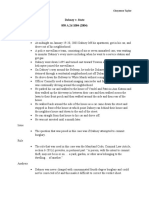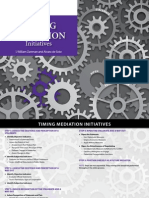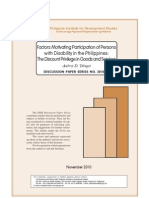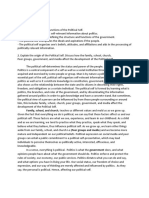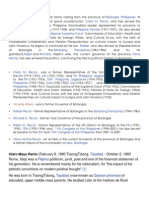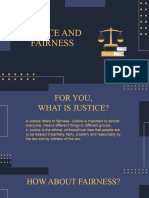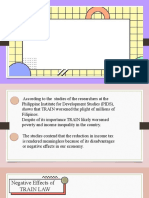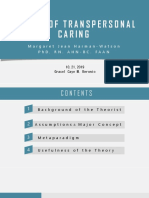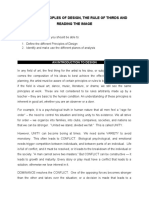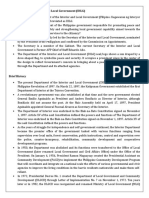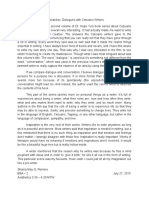0 ratings0% found this document useful (0 votes)
140 viewsWhat Is DILG
What Is DILG
Uploaded by
iLoveMarshaThe Department of the Interior and Local Government (DILG) traces its origins to the Philippine Revolution of 1897 when the Katipunan government established the first Department of Interior. Over the years its roles and responsibilities have expanded from supervision of local units to include functions like public safety, counterinsurgency, and disaster response. The DILG was established through legislation in 1990 by merging local government and police functions after over 40 years of separation. Today the DILG faces challenges around local autonomy, peace and order, and public safety.
Copyright:
© All Rights Reserved
Available Formats
Download as DOCX, PDF, TXT or read online from Scribd
What Is DILG
What Is DILG
Uploaded by
iLoveMarsha0 ratings0% found this document useful (0 votes)
140 views2 pagesThe Department of the Interior and Local Government (DILG) traces its origins to the Philippine Revolution of 1897 when the Katipunan government established the first Department of Interior. Over the years its roles and responsibilities have expanded from supervision of local units to include functions like public safety, counterinsurgency, and disaster response. The DILG was established through legislation in 1990 by merging local government and police functions after over 40 years of separation. Today the DILG faces challenges around local autonomy, peace and order, and public safety.
Original Description:
Contains basic information about DILG and an observed analysis on their working environment
Original Title
What is DILG
Copyright
© © All Rights Reserved
Available Formats
DOCX, PDF, TXT or read online from Scribd
Share this document
Did you find this document useful?
Is this content inappropriate?
The Department of the Interior and Local Government (DILG) traces its origins to the Philippine Revolution of 1897 when the Katipunan government established the first Department of Interior. Over the years its roles and responsibilities have expanded from supervision of local units to include functions like public safety, counterinsurgency, and disaster response. The DILG was established through legislation in 1990 by merging local government and police functions after over 40 years of separation. Today the DILG faces challenges around local autonomy, peace and order, and public safety.
Copyright:
© All Rights Reserved
Available Formats
Download as DOCX, PDF, TXT or read online from Scribd
Download as docx, pdf, or txt
0 ratings0% found this document useful (0 votes)
140 views2 pagesWhat Is DILG
What Is DILG
Uploaded by
iLoveMarshaThe Department of the Interior and Local Government (DILG) traces its origins to the Philippine Revolution of 1897 when the Katipunan government established the first Department of Interior. Over the years its roles and responsibilities have expanded from supervision of local units to include functions like public safety, counterinsurgency, and disaster response. The DILG was established through legislation in 1990 by merging local government and police functions after over 40 years of separation. Today the DILG faces challenges around local autonomy, peace and order, and public safety.
Copyright:
© All Rights Reserved
Available Formats
Download as DOCX, PDF, TXT or read online from Scribd
Download as docx, pdf, or txt
You are on page 1of 2
What DILG is
The present Department of the Interior and Local
Government (DILG) traces its roots from the Philippine
Revolution of 1897. On March 22, 1897, the Katipunan
Government established the first Department of Interior at
the Tejeros Convention.
A revolutionary government was also established at that
time and the new government elected General Emilio
Aguinaldo as President and Andres Bonifacio as Director
of Interior, although Bonifacio did not assume the post. At
the Naic Assembly held on April 17, 1897, President Aguinaldo appointed General
Pascual Alvarez as Secretary of the Interior.
The Department of Interior was enshrined in the Biak-na-Bato Constitution signed on
November 1, 1897. Article XV of the said Constitution defined the powers and functions
of the Department that included statistics, roads and bridges, agriculture, public
information and posts, and public order.
As the years of struggle for independence and self-government continued, the Interior
Department became the premier office of the government tasked with various functions
ranging from supervision over local units, forest conservation, public instructions, control
and supervision over the police, conter-insurgency, rehabilitation, community
development and cooperatives development programs.
In 1950, the Department was abolished and its functions were transferred to the Office of
Local Government (later named Local Government and Civil Affairs Office) under the
Office of the President. On January 6, 1956, President Ramon Magsaysay created the
Presidential Assistant on Community Development (PACD) to implement the Philippine
Community Development Program that will coordinate and integrate on a national scale
the efforts of various governmental and civic agencies to improve the living conditions in
the barrio residents nationwide and make them self-reliant.
In 1972, Presidential Decree No. 1 created the Department of Local Government and
Community Development (DLGCD) through Letter of Implementation No. 7 on November
1, 1972. Ten years later or in 1982, the DLGCD was reorganized and renamed Ministry
of Local Government (MLG) by virtue of Executive Order No. 777; and in 1987, it was
further reorganized and this time, renamed Department of Local Government (DLG) by
virtue of Executive Order No. 262.
Again, on December 13, 1990, the DLG underwent reorganization into what is now known
as the Department of the Interior and Local Government (DILG) by virtue of Republic Act
No. 6975. The passage of RA 6975 paved the way for the union of the local governments
and the police force after more than 40 years of separation.
Today, the Department faces a new era of meeting the challenges of local autonomy,
peace and order, and public safety
How they are as an Organization
The organization is strongly determined to treat their employees and subordinates with
respect and thoughtfulness. They want to be trusted by their employees and subordinates
for their safety and health, at home, at work, at travels – physically, mentally, and
psychologically.
Communication is important between the people in the organization. They believe it is the
key in solving problems and in improving their performance in work. Being an organization
that establishes and prescribe rules, they are strict with theirs and consequences will be
rightfully served. The organization is frequent in providing assistance towards their
employees, such as mentoring them, to further be productive. Being helpful to one
another can relieve their stress, they say. It seems they find comfort from their aid and it
assures them with their down feelings.
Discrimination is highly discouraged in their workplace. They encouraged their people to
be sensitive of their feelings, because personal life and work life are two different things
and should therefore be separated. Work diversity can be observed in the workplace,
especially on the preference of gender. But they don’t mind such trivial things. They treat
each other equally.
Self-fulfillment drives them to continue what they are doing. No matter the incentives. No
matter the salary they receive. It doesn’t matter to them. They continue to work, because
of the gratefulness they receive; because of the smiles they see on people’s face in
success; because they want to help those in need; and because of their family, and to
show them that they did good.
Stress will always be present in their workplace, whether it be because of the actual work
or because of small things like misplaced staplers. But they handle it well because they
help one another. They tend to not leave a man behind in their work. It’s admirable really.
However, they are situations that they can control, such as forces of nature. During that,
they set aside irrelevant stuffs and focus more on solving the problem.
They value their stakeholders. They value their opinion and internalize their ideas. Focus
on the options that will benefit them. But apparently, in the end, majority will rule, so we
don’t know how to feel with that.
Overall, we believe the organization is doing well. They are doing well in treating their
people. They are really dedicated with their job. They don’t let obstacles and problems
get to them to affect their performance. We might as well call them workaholic. They seek
peace and efficiency in their workplace.
You might also like
- Case Brief Dabney v. StateDocument2 pagesCase Brief Dabney v. StateKitty ReneeNo ratings yet
- American Culture - The American DreamDocument3 pagesAmerican Culture - The American DreamIulianaLacramioaraNo ratings yet
- Term Paper Ob Bloc Voting in The INCDocument9 pagesTerm Paper Ob Bloc Voting in The INCKelly Diane LigosNo ratings yet
- People vs. AgapinayDocument10 pagesPeople vs. AgapinayRaezel Louise VelayoNo ratings yet
- Timing Mediation InitiativesDocument57 pagesTiming Mediation InitiativesDax TibusNo ratings yet
- Uts Chapter 1 Lesson 2Document15 pagesUts Chapter 1 Lesson 2John Jerome GironellaNo ratings yet
- Position Paper - ElangaDocument2 pagesPosition Paper - ElangaJanro Elanga100% (1)
- Joseph EstradaDocument20 pagesJoseph EstradasakuraleeshaoranNo ratings yet
- The 7 - Step Moral Reasoning ModelDocument9 pagesThe 7 - Step Moral Reasoning ModelGerard de QuirozNo ratings yet
- Salient Provisions of The Following Legal Bases of NSTP Law Commonwealth Act No. 1 (National Defense Act-1935)Document2 pagesSalient Provisions of The Following Legal Bases of NSTP Law Commonwealth Act No. 1 (National Defense Act-1935)Edgar Macalalad100% (1)
- 10 Political Filipino ScientistDocument18 pages10 Political Filipino ScientistJulius MichaelNo ratings yet
- Delving On The Philosophies of Emilio JacintoDocument1 pageDelving On The Philosophies of Emilio JacintoLovelle Marie Role100% (1)
- Factors Motivating Participation of Persons With Disability in The PhilippinesDocument23 pagesFactors Motivating Participation of Persons With Disability in The PhilippinesVERA FilesNo ratings yet
- Politicalself 1Document3 pagesPoliticalself 1Adrian SantiagoNo ratings yet
- Answers in LMC2 in NSTP by Sherlyn S. OlinoDocument5 pagesAnswers in LMC2 in NSTP by Sherlyn S. OlinoSherlyn OlinoNo ratings yet
- FINAL Historical Analysis of The Philippine ConstitutionDocument11 pagesFINAL Historical Analysis of The Philippine ConstitutionJona Addatu100% (2)
- Impact of Wrong Course Choice On The Students' Academic Performance and Psychological Health and The Factors Influencing Students' DecisionDocument15 pagesImpact of Wrong Course Choice On The Students' Academic Performance and Psychological Health and The Factors Influencing Students' DecisionHanz Amithy Ness PanesNo ratings yet
- Lesson 2 - The Self From Various Perspective - SociologyDocument2 pagesLesson 2 - The Self From Various Perspective - SociologyKaryll Heart LayugNo ratings yet
- Lesson 8 - The Judicial BranchDocument31 pagesLesson 8 - The Judicial BranchFliss YvuseinNo ratings yet
- History Report Gloria Macapagal ArroyoDocument8 pagesHistory Report Gloria Macapagal ArroyoAnnhtak PNo ratings yet
- Persuasive EssayDocument2 pagesPersuasive EssayJemma IsaNo ratings yet
- Gender and Media Reaction PaperDocument3 pagesGender and Media Reaction PaperKristel PamonNo ratings yet
- Recto ClanDocument8 pagesRecto ClanNica Altarez MañaboNo ratings yet
- History of Cooperative in The PhilippinesDocument21 pagesHistory of Cooperative in The PhilippinesNichole MendozeNo ratings yet
- EthicsJustice-And-Fairness Finals ReportingDocument38 pagesEthicsJustice-And-Fairness Finals ReportingannahsenemNo ratings yet
- Do You Agree That GENDER Should Be Personally Discovered and Asserted and Not Dictated by Culture and SocietyDocument1 pageDo You Agree That GENDER Should Be Personally Discovered and Asserted and Not Dictated by Culture and SocietyBlundell Gayle Pascua BautistaNo ratings yet
- Abnormal Psychology ReviewerDocument14 pagesAbnormal Psychology ReviewerLadee KharryleNo ratings yet
- ResearchDocument25 pagesResearchRuby Thea Sison100% (1)
- Tennie Marie Lesson 28Document7 pagesTennie Marie Lesson 28Adelfa MoralesNo ratings yet
- Negative Effects of Train LawDocument9 pagesNegative Effects of Train LawChristine NolascoNo ratings yet
- Essay On Bangsamoro Youth, Bangsamoro's FutureDocument3 pagesEssay On Bangsamoro Youth, Bangsamoro's Futurealican karimNo ratings yet
- Accomplishment Report: College of Business and ManagementDocument2 pagesAccomplishment Report: College of Business and ManagementJhunry TañolaNo ratings yet
- Final Masts Guidelines 2024 1Document50 pagesFinal Masts Guidelines 2024 1Christle ManaloNo ratings yet
- Duty Versus InclinationDocument2 pagesDuty Versus InclinationSarah Sanchez100% (1)
- Research PaperDocument29 pagesResearch PaperLorebel ChuaNo ratings yet
- Jean Watson Report 8 TFNDocument19 pagesJean Watson Report 8 TFNBTW DespairNo ratings yet
- DSWD Hiv Referral Book (1) Final and PublishedDocument98 pagesDSWD Hiv Referral Book (1) Final and PublishedRonz RoganNo ratings yet
- Learning & Memory: Introduction To PsychologyDocument42 pagesLearning & Memory: Introduction To Psychology小给No ratings yet
- Pointers in EthicsDocument6 pagesPointers in EthicsKim HyunaNo ratings yet
- MODULE 3.1 Business Ethics and Ethical Decision - MakingDocument26 pagesMODULE 3.1 Business Ethics and Ethical Decision - MakingDonna DuhigNo ratings yet
- Gender and SocietyDocument30 pagesGender and SocietyRonilyn ChicoNo ratings yet
- Gender and Society BSTM Jan 13 2023Document19 pagesGender and Society BSTM Jan 13 2023Akira PajulasNo ratings yet
- Appendix 1 NSTP Areas of CocernDocument2 pagesAppendix 1 NSTP Areas of CocernIan Conan JuanicoNo ratings yet
- Section 9 Module 2Document13 pagesSection 9 Module 2Jonel Azores BalondoNo ratings yet
- Dr. Rafael Dine-WPS OfficeDocument7 pagesDr. Rafael Dine-WPS Officejonathan robregadoNo ratings yet
- Voters EducationDocument26 pagesVoters EducationRaymart GonzagaNo ratings yet
- Moral Theories: Presented By: Sedrick M. MallariDocument27 pagesMoral Theories: Presented By: Sedrick M. MallariAlyssa De PaduaNo ratings yet
- Political DysnastyDocument13 pagesPolitical DysnastystevensonaguinaldoNo ratings yet
- ISLAMIC Da'Wah Council of The Philippines Vs Executive SecDocument11 pagesISLAMIC Da'Wah Council of The Philippines Vs Executive Secwiggie27No ratings yet
- NSTP PresentationDocument13 pagesNSTP PresentationYatchin KanegawaNo ratings yet
- Genetics Lab Exercise 10 - The Tools of DNA TechnologyDocument7 pagesGenetics Lab Exercise 10 - The Tools of DNA Technologybry uyNo ratings yet
- Case AnalysisDocument7 pagesCase AnalysisRichelle Anne MillanNo ratings yet
- Legitimacy and VoiceDocument9 pagesLegitimacy and VoiceHoney Grace TinacoNo ratings yet
- Social Science and Philosophy Gee2 PrelimDocument5 pagesSocial Science and Philosophy Gee2 PrelimDane CabalteraNo ratings yet
- Are Women Smarter Then Men Argumentative Essay (Draft)Document1 pageAre Women Smarter Then Men Argumentative Essay (Draft)Marigin MutiaNo ratings yet
- Federalism Position Paper - EditedDocument3 pagesFederalism Position Paper - EditedWilmarie Hope AlilingNo ratings yet
- Describing The Use of Freedom Wall in Expressing Students' EmotionDocument10 pagesDescribing The Use of Freedom Wall in Expressing Students' EmotionJournal of Interdisciplinary PerspectivesNo ratings yet
- Citizenship and Good GovernanceDocument5 pagesCitizenship and Good GovernancerecoringaNo ratings yet
- PDF NSTP Module 1 Lesson 1Document9 pagesPDF NSTP Module 1 Lesson 1Rex Montero MisaNo ratings yet
- Lesson 12 Political SelfDocument5 pagesLesson 12 Political SelfMary Joy CuetoNo ratings yet
- Case StudyDocument3 pagesCase Studynorhaine candao100% (1)
- Gerona Vs Secretary of Education, GR # L-13954 DIGESTDocument2 pagesGerona Vs Secretary of Education, GR # L-13954 DIGESTNichole LusticaNo ratings yet
- Art Appreciation Module 1 Lesson 8Document20 pagesArt Appreciation Module 1 Lesson 8Walter John AbenirNo ratings yet
- Department of The Interior and Local Government (DILG)Document6 pagesDepartment of The Interior and Local Government (DILG)Arthur F. AnchetaNo ratings yet
- Western Classical Plays and OperasDocument21 pagesWestern Classical Plays and OperasiLoveMarshaNo ratings yet
- Teaching MethodsDocument34 pagesTeaching MethodsiLoveMarshaNo ratings yet
- Philippine Income TaxationDocument179 pagesPhilippine Income TaxationiLoveMarshaNo ratings yet
- Use Case: Placing An Order (To Replenish Stock)Document1 pageUse Case: Placing An Order (To Replenish Stock)iLoveMarshaNo ratings yet
- Deductions From Gross Estate - PhilippinesDocument70 pagesDeductions From Gross Estate - PhilippinesiLoveMarshaNo ratings yet
- Payback PeriodDocument14 pagesPayback PeriodiLoveMarshaNo ratings yet
- Comparing NPV and IRR TechniquesDocument16 pagesComparing NPV and IRR TechniquesiLoveMarshaNo ratings yet
- Philosophy and Its BranchesDocument1 pagePhilosophy and Its BranchesiLoveMarshaNo ratings yet
- KulokabildoDocument2 pagesKulokabildoiLoveMarshaNo ratings yet
- Turbo CDocument11 pagesTurbo CiLoveMarshaNo ratings yet
- School Teachers Pay TLR PaymentsDocument4 pagesSchool Teachers Pay TLR PaymentsGreg NowakNo ratings yet
- Case Digest People vs. ValdezDocument3 pagesCase Digest People vs. Valdezjulandmic967% (3)
- NCST Pamphlet EnglishDocument8 pagesNCST Pamphlet EnglishVkook ForeverNo ratings yet
- ComparisonDocument3 pagesComparisonLac NicoNo ratings yet
- THEO 02 Human RightsDocument21 pagesTHEO 02 Human RightsJodit SantanderNo ratings yet
- Adjudication and Penalties Under SEBI ActDocument11 pagesAdjudication and Penalties Under SEBI ActMukesh TomarNo ratings yet
- En MOU Canada-UK Coop Missions Rev MCR (Printed 21 Sept 2012)Document14 pagesEn MOU Canada-UK Coop Missions Rev MCR (Printed 21 Sept 2012)iPoliticsCANo ratings yet
- Rights and Privileges of A TeacherDocument67 pagesRights and Privileges of A TeacherMarx Lewis Barquilla100% (1)
- Van Niekerk 2012 Constitutional Protection of Common Law The Endurance of The Civilian Tradition in Southern AfricaDocument20 pagesVan Niekerk 2012 Constitutional Protection of Common Law The Endurance of The Civilian Tradition in Southern Africalynsay.joubertNo ratings yet
- Annex NamesDocument41 pagesAnnex Namesnoahgene delrioNo ratings yet
- MOU SampleDocument2 pagesMOU SampleCenro ValenciaNo ratings yet
- Fundamental Rights (Article 12 To 35) - PSC ExpertttDocument4 pagesFundamental Rights (Article 12 To 35) - PSC Expertttamalsuresh1503No ratings yet
- UCSP Pointers For ReviewDocument2 pagesUCSP Pointers For Reviewsohlox1.katagakiNo ratings yet
- Frame Work of Employee Relation Law, Professional Practices, Lahore Garrison UniversityDocument25 pagesFrame Work of Employee Relation Law, Professional Practices, Lahore Garrison UniversitytouseefaqNo ratings yet
- 6.4 Hornilla vs. SalunatDocument1 page6.4 Hornilla vs. SalunatI took her to my penthouse and i freaked itNo ratings yet
- Coverage/Exemption.: Please CiteDocument4 pagesCoverage/Exemption.: Please CiteJerry SerapionNo ratings yet
- CBSE Class 12 Political Science Revision Notes Chapter-2 The End of BipolarityDocument4 pagesCBSE Class 12 Political Science Revision Notes Chapter-2 The End of BipolaritygouravNo ratings yet
- Labor LawDocument179 pagesLabor LawChristine Rose LaguraNo ratings yet
- History of EIA Systems and Measures Taken Around The WorldDocument10 pagesHistory of EIA Systems and Measures Taken Around The WorldTishana HarryNo ratings yet
- Environmental Law and Sustainable DevelopmentDocument2 pagesEnvironmental Law and Sustainable DevelopmentAaronNo ratings yet
- HSY2601 - Assignment 02Document6 pagesHSY2601 - Assignment 02Nhlakana Kay KhwelaNo ratings yet
- # 5 Korean WarDocument29 pages# 5 Korean War230771No ratings yet
- WaiverDocument5 pagesWaiverKleyr De Casa AlbeteNo ratings yet
- College Prospectus 2022-23 MirandaDocument89 pagesCollege Prospectus 2022-23 MirandaamritharukNo ratings yet
- Herbert MarcuseDocument24 pagesHerbert MarcuseAdam Syahreza100% (1)
- RECENT DEVELOPMENT IN INTERNATIONAL CRIMINAL LAW Decoding The Verisimilitude of Crime of Aggression Task 3Document8 pagesRECENT DEVELOPMENT IN INTERNATIONAL CRIMINAL LAW Decoding The Verisimilitude of Crime of Aggression Task 3Nikchen TamangNo ratings yet
